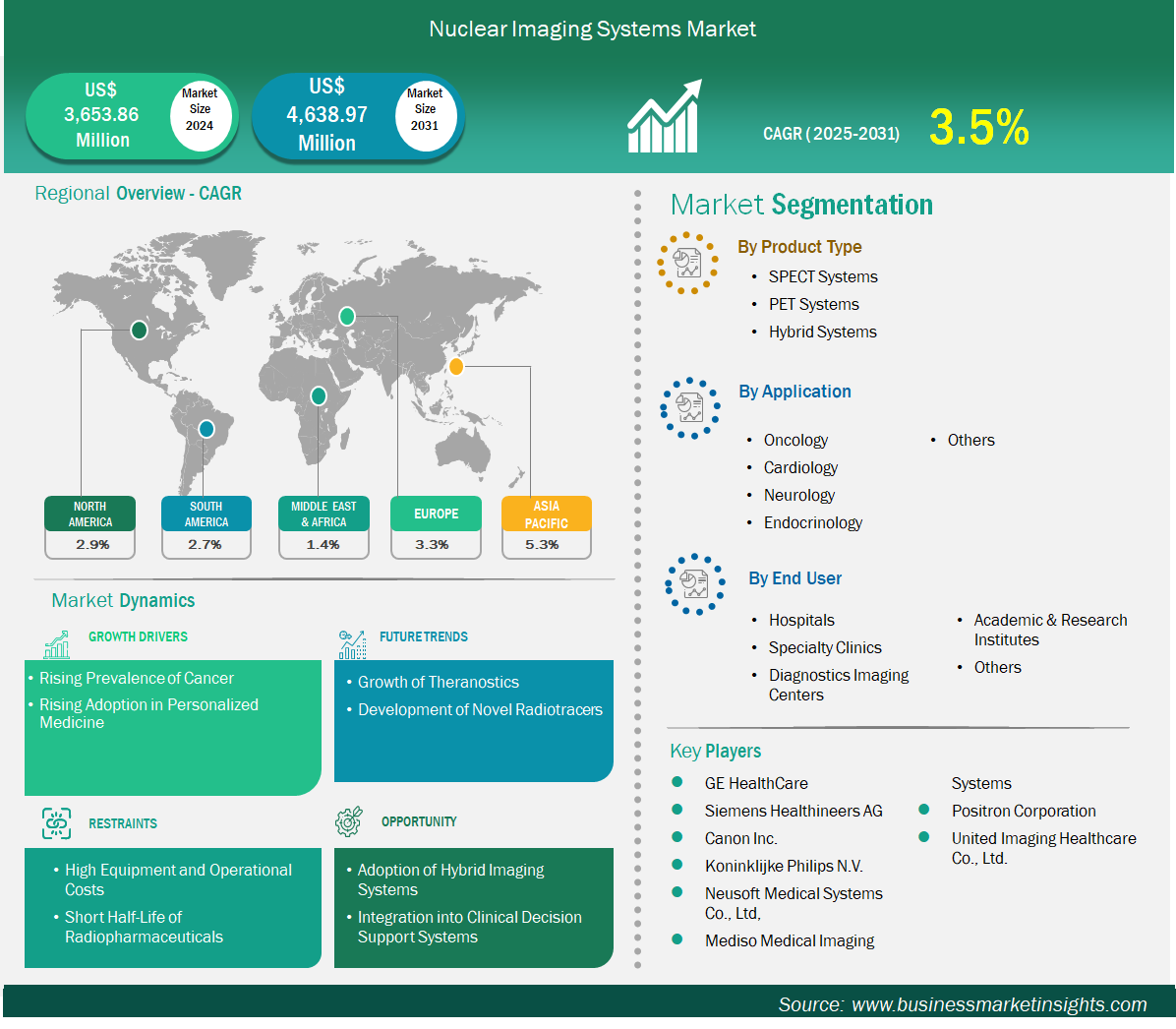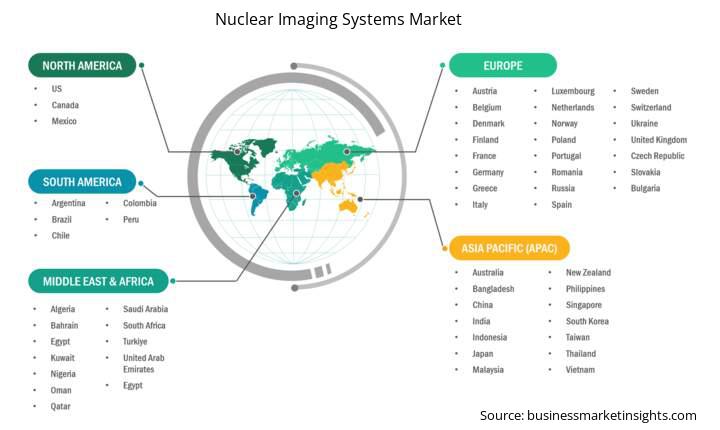Nuclear Imaging Systems Market Outlook (2021-2031)
No. of Pages: 200 | Report Code: BMIPUB00031639 | Category: Life Sciences
No. of Pages: 200 | Report Code: BMIPUB00031639 | Category: Life Sciences
The Nuclear Imaging Systems market size is expected to reach US$ 4,638.97 million by 2031 from US$ 3,653.86 million in 2024. The market is estimated to record a CAGR of 3.5% from 2025 to 2031.
Executive Summary and Global Market Analysis:
There has been steady growth in the global nuclear imaging systems market, driven by heightened demand for advanced functional imaging in oncology, cardiology, and neurology. Unlike conventional imaging, nuclear methods such as PET and SPECT offer imaging of physiologic and metabolic processes, hence allowing earlier and more precise diagnosis. Individualized medicine and theranostics have gained popularity and are expected to continue increasing the pace of adoption in which nuclear imaging is used in planning and monitoring treatment. Further technological developments with hybrid systems such as PET/CT and SPECT/CT are providing better diagnostic accuracy and expanding clinical indications.
In line with the adoption rate, the global nuclear imaging systems market stood at US$ 3,653.86 million in 2024 and is expected to reach US$ 4,638.97 million by 2031. Moreover, novel radiotracers are being developed to widen their use in different disease areas. High cost, cumbersome procedures, and complex regulations, while posing a growth challenge, represent hidden opportunities across emerging nations where healthcare investments are steadily on the rise-aided by Al and digital workflows-greatly favoring the future growth of nuclear imaging technologies on a global scale.
Nuclear Imaging Systems Market Strategic Insights

Nuclear Imaging Systems Market Segmentation Analysis
Key segments that contributed to the derivation of the nuclear imaging systems market analysis are product type, application, and end user.
Nuclear Imaging Systems Market Drivers and Opportunities:
Rising Prevalence of Cancer
The increasing global burden of cancer is a major driver for the nuclear imaging systems market. Cancer diagnosis, staging, and monitoring need to have high-precision imaging that will identify abnormalities at earlier, usually asymptomatic stages. Nuclear imaging modalities like PET and SPECT are very capable of detecting metabolic and molecular activity, and hence they are indispensable aids in oncology. These modalities provide superior sensitivity over conventional anatomical imaging, particularly in the detection of metastases and in the evaluation of response to treatment.
For instance, according to the data published by the Global Cancer Observatory (GCO), ~19,976,499 new cancer cases were reported in 2022 across the globe. In addition, cancer resulted in 9,743,832 deaths globally in 2022.
With cancer incidence on the rise worldwide because of population aging, lifestyle, and environmental factors, demand for accurate and effective imaging devices increases accordingly. It compels the hospitals and diagnostic facilities to invest in sophisticated nuclear imaging systems, further driving market growth and innovation in the development of radiopharmaceuticals.
Rising Adoption in Personalized Medicine
As the adoption of personalized medicines increases the demand for nuclear imaging system is likely to increase. Personalized medicine involves individualized treatment strategies for patients based on their biological makeups, which necessitates accurate diagnostic imaging tools. Nuclear imaging, especially PET and SPECT, comes into prominence in this strategy by allowing disease activity to be visualized at the molecular level. It assists clinicians in selecting targeted therapies, tracking response to treatment, and making real- time plan adjustments, enhancing patient outcomes. Radiotracers employed in nuclear imaging are capable of detecting how a certain therapy is engaging with a patient's body, so it is perfect for cancer treatment, cardiology, and neurological diseases. As healthcare systems become increasingly precision-based, incorporation of nuclear imaging into clinical practices becomes crucial, and hence there is more investment in equipment, software, and tracer development.
Nuclear Imaging Systems Market Size and Share Analysis
By product type, the nuclear imaging systems market is segmented into SPECT systems, PET systems and hybrid systems. The PET systems segment dominated the market in 2024. PET systems are dominant due to their superior image resolution, functional imaging capabilities, and increasing use in oncology. Growing cancer rates and improved tracer availability drive adoption in advanced diagnostic settings.
By application, the nuclear imaging systems market is segmented into oncology, cardiology, neurology, endocrinology and others. The oncology segment dominated the market in 2024. Oncology leads nuclear imaging use as PET and hybrid systems provide precise tumor detection, staging, and monitoring. Their critical role in early cancer diagnosis supports their dominance across healthcare systems globally.
By end user, the market is segmented into hospitals, specialty clinics, diagnostics imaging centers, academic & research institutes and others. The hospitals segment held the largest share of the market in 2024. Hospitals dominate nuclear imaging usage due to high patient volume, advanced infrastructure, access to radiopharmaceuticals, and integration of imaging with oncology, cardiology, and neurology services under one roof for comprehensive care.
Nuclear Imaging Systems Market Report Highlights
Report Attribute
Details
Market size in 2024
US$ 3,653.86 Million
Market Size by 2031
US$ 4,638.97 Million
Global CAGR (2025 - 2031) 3.5%
Historical Data
2021-2023
Forecast period
2025-2031
Segments Covered
By Product Type
By Application
By End User
Regions and Countries Covered
North America
Europe
Asia-Pacific
South and Central America
Middle East and Africa
Market leaders and key company profiles
Nuclear Imaging Systems Market Report Coverage and Deliverables
The "Nuclear Imaging Systems Market Size and Forecast (2021–2031)" report provides a detailed analysis of the market covering below areas:
Nuclear Imaging Systems Market Country and Regional Insights

The geographical scope of the nuclear imaging systems market report is divided into five regions: North America, Asia Pacific, Europe, Middle East & Africa, and South & Central America. The nuclear imaging systems market in Asia Pacific is expected to grow significantly during the forecast period.
The Asia Pacific nuclear imaging systems market is segmented into China, Japan, South Korea, India, Australia, New Zealand, Indonesia, Malaysia, Philippines, Singapore, Thailand, Vietnam, Taiwan, Bangladesh and Rest of Asia. Asia Pacific nuclear imaging systems market is showing rapid growth with increasing prevalence of cancer, mounting neurological disorders, and demand for early and precise diagnosis. China, India, and Japan are investing a lot in healthcare equipment, including sophisticated diagnostic imaging devices like PET and SPECT. The rising adoption of precision medicine and targeted diagnostics is also driving adoption, especially in oncology and neurology. Favorable government policies, increased medical tourism, and better access to radiopharmaceuticals are also growing market potential. But issues like high equipment prices, regulatory barriers, and a lack of qualified nuclear medicine professionals continue to hinder growth in certain regions of the market. Despite these limitations, increasing awareness, improving reimbursement scenarios, and the rise of hybrid imaging systems are creating significant opportunities for market expansion across Asia Pacific.
Nuclear Imaging Systems Market Research Report Guidance
Nuclear Imaging Systems Market News and Key Development:
The nuclear imaging systems market is evaluated by gathering qualitative and quantitative data post primary and secondary research, which includes important corporate publications, association data, and databases. A few of the key developments in the nuclear imaging systems market are:
Key Sources Referred:
The Nuclear Imaging Systems Market is valued at US$ 3,653.86 Million in 2024, it is projected to reach US$ 4,638.97 Million by 2031.
As per our report Nuclear Imaging Systems Market, the market size is valued at US$ 3,653.86 Million in 2024, projecting it to reach US$ 4,638.97 Million by 2031. This translates to a CAGR of approximately 3.5% during the forecast period.
The Nuclear Imaging Systems Market report typically cover these key segments-
The historic period, base year, and forecast period can vary slightly depending on the specific market research report. However, for the Nuclear Imaging Systems Market report:
The Nuclear Imaging Systems Market is populated by several key players, each contributing to its growth and innovation. Some of the major players include:
The Nuclear Imaging Systems Market report is valuable for diverse stakeholders, including:
Essentially, anyone involved in or considering involvement in the Nuclear Imaging Systems Market value chain can benefit from the information contained in a comprehensive market report.